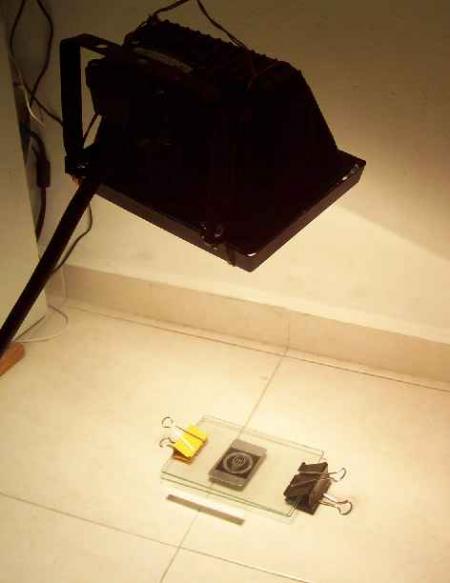Making plates for letterpress.
Yes, I’m one more person interested in making plates (metal, zinc) for letterpress.
I found a enamel to make photoengravings but I’ve had some problems. I followed all the directions but in the last step I’ve failed. The enamel (photoresist) coudn’t resist. In just some seconds the enamel was destroyed and I coudn’t etch the design. Here there are some photographs with the steps I’ve followed. I don’t know how to make the enamel hard and more resistant. This enamel is from Lith-kem and uses a sensibilizer. As you can see the developed it’s perfect but the problem is when I use the acid bath. I uses nitric acid 1part and 11 water part.
Any help I would be very thankfull.
If you need more information I coud be more specific.
My english isn’t very good, sorry.

1cubierto_todo_a_mano.jpg

2centrifugando_emulsion.jpg

3insolado_emulsion.jpg

4emulsion_revelada.jpg

5no_resiste_emulsion.jpg

6fallo_emulsion.jpg
Rengamb:
If indeed the material you are using is an enamel, you might have to harden it by baking. You might also try to clean the surface of the zinc prior to coating with a very fine abrasive and water slurry to make certain it is very clean and will accept the coating. Of course, make certain it is rinsed and dry before coating.
Are you immersing the plate upside down in the tray of acid? This will allow the surface to keep itself clean and the byproducts of the etching process will drop out into the solution rather than stay on top of the plate.
Keep trying. Perhaps someone will give you one hint which will make the difference.
John Henry
Thanks for the advises.
I cleaned the surface with ajax, someone told me that it contain pumice (white from spain) a white dust with water, and after that I’ve rinsed it with water tap. After that I dried the plate with a drier.
I’ve tried harden the enamel by baking but it seems to be the same thing. I’ve tried in differents tempertures and timings.
I’ve tried to using a hardener or something like that. It’s like chromic acid or oxide of chrome. It’s part of the process but someone told me that it is not very necessary.
I’ll just wait for more help.
thank you very much.
Here is a photograph or the product.
esmalteproductocompleto.jpg
Congratulations Rengamb. This was a great result for your first try at zinc-engraving. The best resit available is “Dragons Blood”, proven over the last 150 years. But the price is now prohibitive (>US$100/oz). Powdered shellac is the next-best, cheapest, alternative, however the fusing is more critical. Instructions are available from me at [email protected]. Keep on trying, your results so far are really encouraging, you haven’t mentioned whether you are using your zinc engravings for letterpress-printing, foil-printing or embossing. Each has a different etch/depth/method.
Try to expose your plate under a strong UV (ultra violet) lightsurce as most of the etching resists are sensitisend for UV. If no other surce is available you can keep it in the sunlight (maybe for 20 minutes).
Keep in mind that during the etching process gasses are developed. The bubbles have to be removed from the surface during the etching process.
Good luck
Hans
Thanks for the advises. I’ve heard about dragon’s blood powder but I think is difficult to find and expensive and it’s not necessary to make photoengravings.
I’ll try again exposing the plate in the sunlight and I’ll show the results. However I’ve found some information about an additive to add to the etching bath. It’s something about acid stearic, something used to make soap. This substance protect the enamel and the side walls of the metal used to etch.
Besides I’d like to make an etching machine. An etching machine provide better and deeper cuts, faster than manual method and much less skill is needed.
I’ve found some diagrams that I’ve included in this post. First is an erlier XX etching machine.
Second and third are 50’s etching machine but it’s more or less the same used in latest years.
Thanks
3_etching_machine.jpg
2_etching_machine.jpg
1_old_etchingmachine.jpg
Rengamb,
this additives work well in etching machines of the sprayer-typ. In manual etchig they will not realy help you. The easier start to etching - even if the material is a bit more expensive - would be a copper plate and Ferric-chloride instead of the Zinc and Nitric-acide, as the tendency to underetching in this combination (Copper-Ferric-chloride)is much less.
If you want to build an etching machine, be aware that ALL the materials you’r going to use have to be acide resistant, which makes them quite costly. As per my experience an upright standing tank does the job if you are not planing to produce dozens of plates a day.
You could also have a look on this site:
www.polymetaal.nl/siteES/shopeswork/enter.html
It is in spanish and you can check out the photoetching films there. Working with films is much easier than with the liquide emulsion.
Good luck with your project
Hans